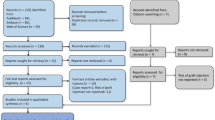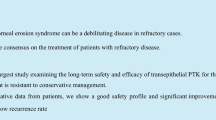Abstract
To analyze the data of the adverse events collected in a single major eye bank (EFS Bourgogne Franche Comté, Besançon, France) for the year 2013 and to report the French data of biovigilance provided by the French National Agency for Medicines and Health Products Safety (ANSM) between 2010 and 2013. we have set up a study of adverse events in 2013, in collaboration with a single eye bank (EFS Bourgogne Franche Comté, Besançon, France). A survey was sent to the surgeon for each delivered corneal button by the eye bank in 2013. They were asked for each grafted patient performed in their center, the type of graft (penetrating keratoplasty, anterior keratoplasty or endothelial keratoplasty), the occurrence of adverse events (primary failure, infectious keratis, endophthalmitis, immune rejection, and other events) and the time interval between surgery and events (Less than 1 postoperative month, between 1 month and 1 year postoperatively, >1 year postoperatively). In 2013, 407 corneal buttons were delivered by the eye bank of Besançon in 21 medical centers which performed corneal grafts and we sent 407 surveys. We received 243 completed questionnaires (59.75%) from 11 centers (52.38%). The global reported rate of adverse events was 27.54% of the graft (n = 65/236 corneal grafts performed in 11 centers in 2013; 20% of Primary graft failure, 11% of infectious keratitis, 1% of endophthalmitis, 34% of rejection, 34% of other incidents). 30.16% of complications were noticed before the first month after surgery versus 52.38% of complications noticed between the first month and the first year after surgery and 17.46% of complications noticed after the post-operative first year The most common causes of adverse events after PK were Immune rejection (13.17%), surgical causes (5.98%) and infection (4.79%) and after EK were Primary graft failure (8.2%) and surgical causes (19.67%). In 2013, in France 0.83% of adverse events were notified in ANSM. For the 236 performed graft issued from a major eye bank (EFS Besançon) in 2013 the global reported rate of post-graft adverse events was 27.54% of the grafts (20% of Primary graft failure, 11% of infectious keratitis, 1% of endophthalmitis, 34% of rejection and 34% of other incidents). Compared to the ANSM data (0.83% of adverse events reported in 2013) this rate is high. This difference can be explained by the low rate of annual notification to the ANSM and shows that biovigilance in France must be more developed. Since biovigilance needs constant improvement for the safety of the graft system, training, information for practitioners, simplifications of procedures and international standardization of the definition are the main points that could be improved.




Similar content being viewed by others
References
Alharbi SS, Alrajhi A, Alkahtani E (2014) Endophthalmitis following keratoplasty: incidence, microbial profile, visual and structural outcomes. Ocul Immunol Inflamm 22:218–223
Chen JY, Jones MN, Srinivasan S et al (2015) Endophthalmitis after penetrating keratoplasty. Ophthalmology 122:25–30
Du DT, Wagoner A, Barone SB et al (2014) Incidence of endophthalmitis after corneal transplant or cataract surgery in a medicare population. Ophthalmology 121:290–298
Dubord PJ, Evans GD, Macsai MS, Mannis MJ, Glasser DB, Strong DM, Noël L, Fehily D (2013) Eye banking and corneal transplantation communicable adverse incidents: current status and project NOTIFY. Cornea 32(8):1155–1166
Edelstein SL, DeMatteo J, Stoeger CG, Macsai MS, Wang CH (2016) Report of the Eye Bank Association of America Medical Review Subcommittee on adverse reactions reported from 2007 to 2014. Cornea 35(7):917–926
Fasolo A, Capuzzo C, Fornea M et al (2011) Risk factors for graft failure after penetrating keratoplasty: 5-year follow-up from the corneal transplant epidemiological study. Cornea 30:1328–1335
Hassan SS, Wilhelmus KR, Dahl P et al (2008) Infectious disease risk factors of corneal graft donors. Arch Ophthalmol 126:235–239
Kaye S, Baddon A, Jones M, Armitage WJ, Fehily D, Warwick RM (2010) A UK scheme for reporting serious adverse events and reactions associated with ocular tissue transplantation. Cell Tissue Bank 11(1):39–46
Kelly TL, Williams KA, Coster DJ (2011) Corneal transplantation for keratoconus: a registry study. Arch Ophthalmol 129:691–697
Kloess PM, Stulting RD, Waring GO III et al (1993) Bacterial and fungal endophthalmitis after penetrating keratoplasty. Am J Ophthalmol 115:309–316
Mannis MJ, Holland EJ, Gal RL et al (2013) The effect of donor age on penetrating keratoplasty for endothelial disease: graft survival after 10 years in the Cornea Donor Study. Ophthalmology 120:2419–2427
Martiniere K, Lucas S, Zorzi P (2008) Events and adverse reactions in biovigilance: descriptive analysis of French national data following a four-year practical experience. Transfus Clin Biol J Soc Fr Transfus Sang 15(4):179–189
Ple-plakon PA, Shtein RM, Musch DC, Blachley T, Saponara F, Woodward MA (2013) Tissue characteristics and reported adverse events after corneal transplantation. Cornea 32(10):1339–1343
Taban M, Behrens A, Newcomb RL et al (2005) Incidence of acute endophthalmitis following penetrating keratoplasty: a systematic review. Arch Ophthalmol 123:605–609
Williams KA, Muehlberg SM, Lewis RF et al (1995) How successful is corneal transplantation? A report from the Australian Corneal Graft Register. Eye (Lond) 9(Pt 2):219–227
Williams KA, Lowe M, Bartlett C, Kelly TL, Coster DJ (2008) Risk factors for human corneal graft failure within the Australian corneal graft registry. Transplantation 86(12):1720–1724
Author information
Authors and Affiliations
Corresponding author
Rights and permissions
About this article
Cite this article
Gauthier, AS., Castelbou, M., Garnier, M.B. et al. Corneal transplantation: study of the data of a regional eye bank for the year 2013 and analysis of the evolution of the adverse events reported in France since 2010. Cell Tissue Bank 18, 83–89 (2017). https://doi.org/10.1007/s10561-016-9593-2
Received:
Accepted:
Published:
Issue Date:
DOI: https://doi.org/10.1007/s10561-016-9593-2




